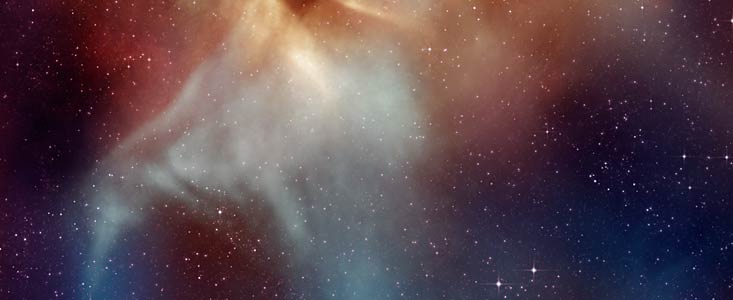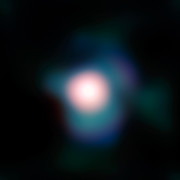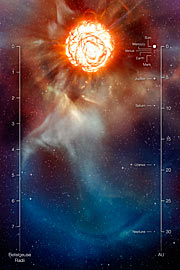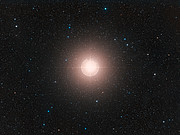Pressmeddelande
En röd jättestjärnas sanna ansikte – nya skarpa bilder på Betelgeuse
Astronomer har tagit de skarpaste bilder någonsin på Betelgeuse, en av de största stjärnor vi känner till.
29 juli 2009
Två forskarlag har använt ESO:s jätteteleskop VLT i Chile för att ta några av de skarpaste bilderna någonsin på stjärnan. Bilderna ger nya insikter i hur sådana bjässar till stjärnor skapar sina mäktiga stjärnvindar.
Betelgeuse ligger 600 ljusår från jorden i Orions stjärnbild. En dag tror astronomer att den kommer att explodera som en supernova. Redan nu håller den på att förlora sina yttre delar ut i rymden i rasande fart.
Nysläppta bilder visar en plym av gas, lika stor som vårt solsystem, som sträcker sig ut från stjärnan. Bilderna har tagits med instrumentet NACO av ett internationellt forskarlag lett av fransmannen Pierre Kervalla vid Paris observatorium.
– Tack vare dessa häpnadsväckande bilder har vi detekterat en stor plym av gas som sträcker sig ut i rymden från Betelgeuse yta, säger Pierre Kervalla, astronom vid Paris observatorium. Plymens utsträckning är minst sex gånger så stor som stjärnans diameter, ungefär avståndet mellan solen och Neptunus.
Kervalla och hans forskarkollegor har använt instrumentet NACO vid Europeiska sydobservatoriets (ESO:s) teleskop VLT.
NACO använder en teknik som heter adaptiv optik för att få fram superskarpa bilder. Den korrigerar för jordens böljande atmosfär. För att få fram den skarpaste bilden tar man många kort och slänger bort alla förutom de allra skarpaste. Denna teknik kallas 'lucky imaging'. Upplösningen är tillräckligt bra för att kunna se en tennisboll på Internationella rymdstationen.
Forskarna har också upptäckt att stjärnans yta pryds av en kokande bubbla som är ungefär lika stor som stjärnan själv.
De tror att det är en sådan bubbla som ligger bakom Betelgeuse underliga plym.
Bubblan på ytan har upptäckts med hjälp av en annan teknik, interferometri, också vid VLT i Chile. Astronomen Keiichi Ohnaka vid Max Planck-Institutet för astronomi i Bonn, tillsammans med kollegor från Frankrike och Italien, har använt instrumentet AMBER, som kombinerar ljuset från flera teleskop för att få fram bilder som är lika skarpa som från ett teleskop med en spegel på 48 meter.
– Våra observationer med AMBER är de skarpaste som någonsin gjorts av Betelgeuse. Dessutom har vi upptäckt hur gasen rör på sig i olika delar av stjärnans yta. Det är första gången man gjort det för en annan stjärna än vår sol, säger Keiichi Ohnaka vid Max Planck-Institutet för astronomi i Bonn.
Nils Ryde är astronom vid Lunds universitet och forskar själv om Betelgeuse, men har inte varit inblandad i de nya rönen.
– Ju mer man tittar på Betelgeuse, desto mer komplex blir bilden, säger Nils Ryde.
– De här resultaten är ett nytt bevis för att Betelgeuse yta består av konvektionsceller precis som solen. Skillnaden är att den har bara några få istället för massor, som solen, säger Nils Ryde.
Nils Ryde tror att den nya bilden av Betelgeuse kan hjälpa astronomer att förstå när stjärnan riskerar att smälla.
– Den är på väg att explodera som en supernova, men vi vet inte om det blir om tio år, hundra år eller hundra tusen år.
Mer information
Pressmeddelande på engelska, bilder och video
Kontakter
Pierre Kervella
Observatoire de Paris-Meudon
Paris, France
Tel: +33 1 45 07 79 66
E-post: Pierre.Kervella@obspm.fr
Keiichi Ohnaka
Max-Planck Institute for Radio Astronomy
Bonn, Germany
Tel: +33 1 45 07 79 66
E-post: kohnaka@mpifr-bonn.mpg.de
Olivier Hainaut
ESO
Garching, Germany
Tel: +49 89 3200 6752
E-post: ohainaut@eso.org
Johan Warell (Presskontakt för Sverige)
ESO:s nätverk för vetenskaplig kommunikation
Skurup, Sverige
Tel: +46-706-494731
E-post: eson-sweden@eso.org
Om pressmeddelandet
| Pressmeddelande nr: | eso0927sv |
| Legacy ID: | PR 27/09 |
| Namn: | Betelgeuse |
| Typ: | Milky Way : Star : Evolutionary Stage : Red Supergiant |
| Facility: | Very Large Telescope |
| Instruments: | AMBER, NACO, VINCI |
| Science data: | 2009A&A...504..115K 2009A&A...503..183O |
Our use of Cookies
We use cookies that are essential for accessing our websites and using our services. We also use cookies to analyse, measure and improve our websites’ performance, to enable content sharing via social media and to display media content hosted on third-party platforms.
ESO Cookies Policy
The European Organisation for Astronomical Research in the Southern Hemisphere (ESO) is the pre-eminent intergovernmental science and technology organisation in astronomy. It carries out an ambitious programme focused on the design, construction and operation of powerful ground-based observing facilities for astronomy.
This Cookies Policy is intended to provide clarity by outlining the cookies used on the ESO public websites, their functions, the options you have for controlling them, and the ways you can contact us for additional details.
What are cookies?
Cookies are small pieces of data stored on your device by websites you visit. They serve various purposes, such as remembering login credentials and preferences and enhance your browsing experience.
Categories of cookies we use
Essential cookies (always active): These cookies are strictly necessary for the proper functioning of our website. Without these cookies, the website cannot operate correctly, and certain services, such as logging in or accessing secure areas, may not be available; because they are essential for the website’s operation, they cannot be disabled.
Functional Cookies: These cookies enhance your browsing experience by enabling additional features and personalization, such as remembering your preferences and settings. While not strictly necessary for the website to function, they improve usability and convenience; these cookies are only placed if you provide your consent.
Analytics cookies: These cookies collect information about how visitors interact with our website, such as which pages are visited most often and how users navigate the site. This data helps us improve website performance, optimize content, and enhance the user experience; these cookies are only placed if you provide your consent. We use the following analytics cookies.
Matomo Cookies:
This website uses Matomo (formerly Piwik), an open source software which enables the statistical analysis of website visits. Matomo uses cookies (text files) which are saved on your computer and which allow us to analyze how you use our website. The website user information generated by the cookies will only be saved on the servers of our IT Department. We use this information to analyze www.eso.org visits and to prepare reports on website activities. These data will not be disclosed to third parties.
On behalf of ESO, Matomo will use this information for the purpose of evaluating your use of the website, compiling reports on website activity and providing other services relating to website activity and internet usage.
Matomo cookies settings:
Additional Third-party cookies on ESO websites: some of our pages display content from external providers, e.g. YouTube.
Such third-party services are outside of ESO control and may, at any time, change their terms of service, use of cookies, etc.
YouTube: Some videos on the ESO website are embedded from ESO’s official YouTube channel. We have enabled YouTube’s privacy-enhanced mode, meaning that no cookies are set unless the user actively clicks on the video to play it. Additionally, in this mode, YouTube does not store any personally identifiable cookie data for embedded video playbacks. For more details, please refer to YouTube’s embedding videos information page.
Cookies can also be classified based on the following elements.
Regarding the domain, there are:
- First-party cookies, set by the website you are currently visiting. They are stored by the same domain that you are browsing and are used to enhance your experience on that site;
- Third-party cookies, set by a domain other than the one you are currently visiting.
As for their duration, cookies can be:
- Browser-session cookies, which are deleted when the user closes the browser;
- Stored cookies, which stay on the user's device for a predetermined period of time.
How to manage cookies
Cookie settings: You can modify your cookie choices for the ESO webpages at any time by clicking on the link Cookie settings at the bottom of any page.
In your browser: If you wish to delete cookies or instruct your browser to delete or block cookies by default, please visit the help pages of your browser:
Please be aware that if you delete or decline cookies, certain functionalities of our website may be not be available and your browsing experience may be affected.
You can set most browsers to prevent any cookies being placed on your device, but you may then have to manually adjust some preferences every time you visit a site/page. And some services and functionalities may not work properly at all (e.g. profile logging-in, shop check out).
Updates to the ESO Cookies Policy
The ESO Cookies Policy may be subject to future updates, which will be made available on this page.
Additional information
For any queries related to cookies, please contact: pdprATesoDOTorg.
As ESO public webpages are managed by our Department of Communication, your questions will be dealt with the support of the said Department.






